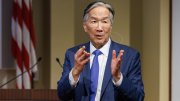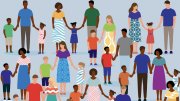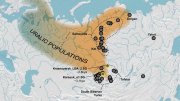Politically, U.S. professors are less liberal than many people believe, but their ranks also include fewer conservatives than in the early 1970s. Meanwhile, centrism is ascendant among faculty members under the age of 35. These are among the conclusions of a major new national study of professors and their politics, also the topic of an October 6 symposium at Harvard organized by the study’s authors, assistant professor of sociology Neil Gross and Solon J. Simmons, assistant professor of sociology at George Mason University.
 The study, says Gross, was intended to move discussions about professors’ political views “away from partisan polemic and back toward rigorous social science.” The seminal comprehensive survey in this area was conducted in 1969 by Everett Carll Ladd and Seymour Martin Lipset, who found that professors were more liberal than members of many other occupations: at that time, “46 percent of professors described their overall political identity as left or liberal, 27 percent as middle of the road, and 28 percent as conservative, with younger faculty members more liberal than older ones.”
The study, says Gross, was intended to move discussions about professors’ political views “away from partisan polemic and back toward rigorous social science.” The seminal comprehensive survey in this area was conducted in 1969 by Everett Carll Ladd and Seymour Martin Lipset, who found that professors were more liberal than members of many other occupations: at that time, “46 percent of professors described their overall political identity as left or liberal, 27 percent as middle of the road, and 28 percent as conservative, with younger faculty members more liberal than older ones.”
But recent decades, Gross and Simmons argue, have brought a reactionary targeting of liberal academicians: “[a] conservative strategy of attempting to influence public opinion on a wide variety of matters by starting think-tanks—most independent of academe—funded by conservative foundations that build and then leverage ties to the increasingly consolidated mass media in order to get their message across; and…the rhetorical strategy that accompanied this institution-building eff ort, of calling into question the legitimacy of intellectuals on the other side of the political aisle who would contest conservative claims.” A wave of faculty studies that appeared in the context of this new order were, according to Gross and Solon, “closer to thinly disguised works of political advocacy intended to back up the charge of liberal bias in academe” than to “thoughtful scientific investigations.”
Moderates Emergent
| Political Orientation by Age | |||
Age | Liberal % | Moderate % | Conservative % |
26-35 | 32.5 | 60.0 | 7.5 |
36-49 | 41.5 | 49.9 | 8.6 |
50-64 | 49.4 | 42.7 | 7.9 |
65+ | 36.9 | 52.3 | 10.8 |
Their own study, which the Chronicle of Higher Education described as “arguably the best-designed survey of American faculty beliefs since the early 1970s,” found that 44 percent of faculty members today are self-described liberal, 46 percent are moderate, and 9 percent are conservative. Only 20 percent voted for George Bush in 2004. The rise in centrism, the study authors say, seems to have come at the expense of conservatives.

While the nearly steady number of liberals teaching in higher education might have been expected, there were surprises. On the question of affirmative action in college admissions, for example, the study (with funding from the Richard Lounsbery Foundation) found, after surveying 1,417 faculty members at 927 colleges, that professors are nearly split on the issue. As compared to the general population, they are also more conservative on certain issues of economic policy. Less than half agreed with the statement, “Business corporations make too much profit,” compared to two-thirds of the American public. In other ways, however, faculty members lean sharply left. Eighty percent believe President Bush misled the American people about the reasons to go to war in Iraq, and 75 percent think having an abortion should be legal “if a woman wants it for any reason.”
The highest concentration of left-leaning academics, the study found, appears in liberal-arts colleges (61 percent liberal), while the lowest (37 percent liberal) is found in community colleges, where conservatives reach their zenith (19 percent conservative). Only 4 percent of professors at liberal-arts colleges identify as conservative. Elite Ph.D.-granting institutions fall in the middle.

Patterns of political belief track disciplines, write Gross and Simmons: for example, more than half of professors in health sciences voted for Bush in 2004, while only 15 percent of humanities faculty members did so. They also track age: 60 percent of professors aged 26 to 35 are moderate, as compared to 50 percent of professors aged 36 to 49, and 43 percent of professors aged 50 to 64.
At the symposium held to discuss the study, some participants emphasized diff erent interpretations of the data. Eliot University Professor Lawrence H. Summers (who three weeks earlier had been disinvited to address the board of regents of the University of California because of faculty pressure) said that he was surprised to find in the survey data “even less ideological diversity in the American university than I had imagined.” This led him “naturally” to question whether professors’ politics aff ect their students. Bass professor of English and American literature and language Louis Menand worried that convergent political beliefs among faculty and students, whether caused by self-selection or conformist socialization—in combination with the long time commitments required to earn a Ph. D.—might stifle beneficial “ferment” and “iconoclasm.”

For their part, the authors hope their work will lay the foundation for “serious social-scientific scholarship” that could explain the “social mechanisms and processes that account for the relative liberalism of the faculty.” What are the eff ects of professors’ politics, they ask, not only on students, but also on “the structure of intellectual fields?” To what extent, they ask, do the “political propensities” of “the contemporary professoriate…both reflect and feed into broader social and cultural dynamics?” These are questions they hope will be the future “subject of lively—and empirically informed…debate.”
Graphics by Stephen Anderson








